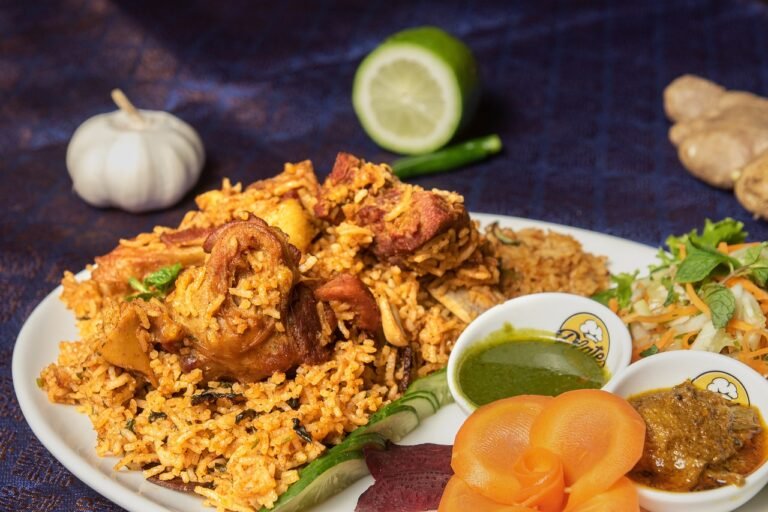Biryani, a fragrant and tasty rice dish darling across the globe, frequently ends up at the focal point of a well-being banter. While certainly flavorful, its lavishness and liberal nature raise worries about its healthful profile. We should dive into the elements that add to biryani’s undesirable standing and investigate ways of making it a more adjusted dinner.
The Guilty Party Fixings
Unhealthy Fixings: Biryani is ordinarily loaded down with fatty fixings like ghee, oil, and rich meat cuts. These fats contribute altogether to the general carbohydrate level.
Refined Sugars: The foundation of biryani is many times white rice, a refined starch that offers minimal dietary benefit past energy.
1. White Rice: Sustenance Realities, Wellbeing Impacts, and How to Cook
Flavors: While many flavors in biryani offer medical advantages, the liberal utilization of some, such as dried chilies, can aggravate the stomach-related framework when consumed in abundance.
Meat: The sort of meat utilized can influence the invigorating effect of biryani. Red meat, particularly handled assortments, is connected to coronary illness and other medical problems.
2. Risk in Red Meat? | Public Establishments of Wellbeing (NIH)
The Cooking System
Profound Broiling: A few biryani recipes include profound searing components like onions or meat, adding to the fat and calorie content.
Long Cooking Time: The delayed cooking interaction can prompt the arrangement of destructive mixtures, particularly when high intensity is utilized.
Wellbeing Suggestions
Weight Gain: The unhealthy and fatty substance of biryani can add to weight gain whenever consumed routinely in huge amounts.
Stomach-related Issues: The blend of rich fixings and flavors can cause stomach-related uneasiness for certain people.
Glucose Spikes: The high starch content of white rice can prompt quick glucose spikes.
3. Food varieties that spike a patient’s blood glucose are not your thought process | Is earthy-colored rice great for diabetics | AMA
Making Biryani Better
While it’s trying to change biryani into a well-being food, a few changes can make it a more adjusted feast:
Pick Lean Protein: Choose less fatty cuts of meat like chicken bosom or fish.
Embrace Entire Grains: Supplant white rice with earthy-colored rice or quinoa for added fiber and supplements.
Diminish Oil and Ghee: Utilize better cooking techniques like barbecuing or baking and limit how much oil or ghee is utilized.
Consolidate Vegetables: Increment the vegetable substance by changing it up to vivid and supplement thick choices.
4. Enjoying Tasty And Healthy Vegetable Biryani – Khalil’s Food
Control Part Sizes: Be aware of piece sizes to stay away from overconsumption.
Balance Your Dinner: Match biryani with a side serving of mixed greens or yogurt to add fiber, protein, and probiotics.
Biryani: A Treat, Not a Staple
It’s memorable that biryani is a celebratory dish, best delighted at times. While it’s feasible to make better variants, offsetting it with other nutritious food varieties in your diet is fundamental. By pursuing informed decisions and rehearsing balance, you can relish the kinds of biryani without undermining your well-being.

5. The Lord of Merriments – Biryani – No Concerns Curries
Extra Tips:
Investigate veggie lover or vegetarian biryani choices for a better bend.
Try different things with various flavors to make remarkable and delightful blends.
Serve biryani with a side of raita for a cooling influence and added probiotics.
By understanding the variables that add to biryani’s undesirable standing and executing these tips, you can partake in this cherished dish while pursuing better decisions.
The Undesirable Truth Behind Biryani
Biryani, a culinary show-stopper praised for its sweet-smelling flavors and rich surfaces, frequently veils a less engaging wholesome profile. While its charm is unquestionable, a nearer assessment uncovers the secret well-being ramifications of this darling dish.
Dismantling Biryani: A Nourishing Breakdown
At its center, biryani is an amicable mix of rice, meat (or once in a while vegetables), and a variety of sweet-smelling flavors. While the blend is enticing to the sense of taste, the hidden fixings and cooking techniques add to its not-great well-being profile.
Rice: The underpinning of biryani is regularly white rice, a refined grain deprived of its supplement-rich wheat and microbe. This abandons a starch-loaded base with negligible fiber and fundamental nutrients. While earthy-colored rice offers a better option with its higher fiber content, it’s not unexpectedly neglected in conventional biryani recipes.
Meat: The decision of meat altogether influences the dietary benefit of biryani. Rich, greasy cuts like sheep or lamb are regularly utilized, expanding the general fat and cholesterol content. Whole chicken or fish can be better choices, but the cooking strategies utilized can discredit these advantages.
Ghee and Oil: An indication of biryani is the generous use of ghee or oil, which greatly enhances the dish’s rich flavor and texture. However, these lipids are heavy in calories and saturated fat, which can enhance the risk of heart sickness and raise cholesterol levels.
Flavors: While many flavors utilized in biryani offer potential medical advantages, their effect is much of the time eclipsed by the overflow of other less-sound fixings. Additionally, the utilization of dried chilies can disturb the stomach-related framework for certain people.
Cooking Strategies: Profound broiling specific parts, like onions, or utilizing high-heat cooking methods can produce harmful mixtures. These strategies further raise the calorie and fat substance of the dish.
Additionally, eating biryani frequently hurts your health:
Weight Gain: The unhealthy and fatty substance of biryani can add to weight gain, particularly when consumed in enormous bits.
Coronary sickness: The abundance of absorbed fat biryani can raise cholesterol levels, extending the risk of coronary disease and other cardiovascular issues.
Stomach-related Issues: The blend of rich trimmings, flavors, and profound cooking procedures can provoke stomach-related disquiet, including expansion, heartburn, and acid reflux.
Glucose Spikes: The high glycemic document of white rice can cause fast spikes in glucose levels, particularly in individuals with diabetes or insulin hindrance.
Supplement Lacks: The prevalence of refined starches in biryani can dislodge supplement-thick food sources from your eating regimen, prompting a lack of fundamental nutrients, minerals, and fiber.
Changing Biryani into a Better Dish
While biryani may not be the embodiment of prosperity, it needn’t bother to be completely illegal. By making wary replacements and changes, you can take part in this delicious dish without disrupting your flourishing
Pick Lean Proteins: Select more smoothed-out cuts of meat like chicken chest or fish, or explore veggie darling or vegan choices like paneer, tofu, or lentils.
Embrace Entire Grains: Trade white rice for earthy-colored rice, quinoa, or other entire grains to increment fiber admission and further develop glucose control.
Decrease Fat: Utilize better cooking strategies like barbecuing, baking, or steaming to limit how much oil or ghee is utilized.
Integrate Vegetables: Change beautiful vegetables to your biryani to help supplement content and improve flavor.
Control Sections: Know about part sizes to hinder overconsumption.
Balance Your Dinner: Match biryani with a side plate of mixed greens or yogurt to add fiber, protein, and probiotics.
By carrying out these changes, you can make a more adjusted form of biryani that fulfills your desires without forfeiting your well-being. Keep in mind, that control is critical. Appreciate biryani as a periodic treat as opposed to a staple in your eating routine.
